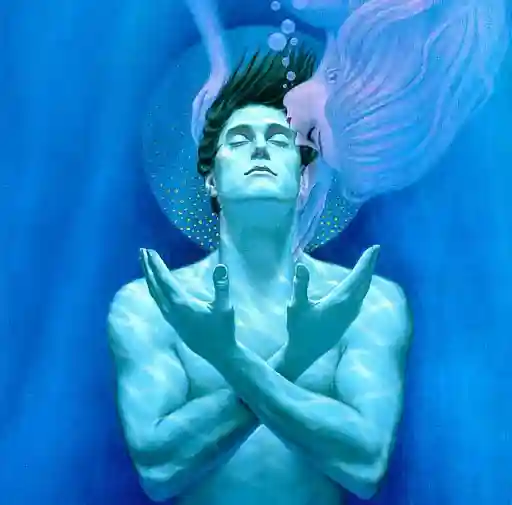LURID: vivid in shocking detail; sensational, horrible in savagery or violence, or, a twice-monthly guide to the merits of the kind of Bad Books you never want your co-workers to know you're reading.
As long as there have been deities there have been devils, pitched in an eternal battle for human souls. From the Sumerians to Scientology, every religion includes dualistic elements, light and dark, good and evil, angelic and diabolic, binary oppositions that keep the faithful fearful – and well-behaved. Devils drive the dark side of each equation. They’re what happens to us if we don’t obey the rules; lying in wait for unwary sinners, they taunt, tempt, and, ultimately, take possession of our minds and flesh, condemning us to bodily destruction and spiritual damnation.
Demonic possession – like the haunted house – is an ancient, cross-cultural, catch-all concept. Through time, it’s provided a useful explanation for mental illness, neurological trauma, Tourette’s syndrome, repressed sexuality, epilepsy, hallucinations and even naughty children. Anyone declared possessed by a demon is permitted to lose control of that vital, civilized part of themselves; they are not responsible for the jerking of their limbs or the obscenities spewing from their mouth. The possessed have passed beyond the state of conscious sin.
As well as serving those who wish to transgress with impunity, a diagnosis of demonic possession is useful to those transgressed against. If supernatural forces are to blame, then there has been no real failure of social order, no genuine threat of rebellion. No human is at fault unless a scapegoat is required. After a suitably qualified witch-hunter, exorcist or demonologist casts out the invisible menace using their invisible weapons, the balance of power is restored. A witch trial or an exorcism makes the perfect showcase for religious and political authorities to reinforce their version of the law – and can make for some dramatic, intense storytelling.
It’s small wonder that dysfunctional individuals throughout history, from the incubi-ridden nuns at Santa Lucia in medieval Italy, to the vengeful Throckmorton family in Elizabethan England, to the hysterical girls of Salem, Massachusetts, have claimed demonic possession as the root of their unchristian behavior. It’s the ultimate defense for deviance of any sort: the devil made me do it.
Within the possession subgenre, superstition always trumps science, not least because wrestling with actual demons generates more thrills than struggling with mental illness. It’s easy to see why such stories have held their appeal over centuries. A diabolically-infested character offers the reader some serious face time with Evil, in all its gurning, grimacing, limb-twisting glory. There’s always a higher power to call on when the conflict gets too tough. And, tellingly, tales of demonic possession exist in the DMZ between supernatural fiction, religious doctrine and historical fact. Attribute the causes where you may, this shit happens in real life.
Sometimes history provides us with the clearest view. A notorious case of mass possession amongst Ursuline nuns in Loudun, France from 1632-7 inspired several twentieth century plays, films and books. Aldous Huxley’s non-fiction novel, The Devils of Loudun, is an ideal introduction to the main concepts, and offers the definitive dissection of possession, exorcism, and the subsequent realization that the only malfeasance involved is the evil that men do.
When the new curé, Urbain Grandier, rides into Loudun in 1617, Huxley describes him as “a fleshier, not unamiable, and only slightly less intelligent Mephistopheles in clerical fancy dress.” Grandier is a priest by default (there weren’t that many job options for younger sons of noble families) rather than a career clergyman, and believes his vow of celibacy isn’t to be taken too seriously. Over the next decade he seduces a number of young Loudun ladies, fathering at least one child.
However – as is so often the way – it’s not the women he ravishes that matter, but the ones he rejects. Foremost among their number is a hunchbacked nun, Sister Jeanne des Anges, Mother Superior at the local convent, who lusts after Grandier from afar. The way Huxley tells it, the venerable nun orchestrates a massive and vindictive fraud, claiming that she and a number of other sisters have become possessed by demons introduced to the convent by Grandier.
Life as a nun in early seventeenth century Europe sucked. Locked in a cloister, denied all comforts of the flesh, half-starved, subjected to sleep deprivation, worked like a dog and forbidden human warmth and connection, it’s no wonder the nuns were highly suggestible and welcomed any opportunity to act up. Feigning demonic possession is the ultimate in attention seeking behavior, and the Loudun nuns worked this angle for all its worth, contorting their bodies, speaking in tongues, and pouring out their repressed sexual fantasies in front of a horrified – but certainly titillated - clerical audience. Sister Jeanne herself confessed that
The devil beclouded me in such a way that I hardly distinguished his desires from mine; he gave me, moreover, such a strong aversion to my religious calling, so that sometimes when he was in my head I tore all of my veils and such of my sisters’ as I could lay hands on; I trampled them underfoot, I chewed them, cursing the hour when I took the vows. All this was done with great violence…”
When they send in the exorcists, the powerbrokers of the Catholic Church use the demon infestation to settle a few other scores. The sloppy-trousered priest, Grandier, is tortured and eventually executed (burned at the stake) for witchcraft – even though Sister Jeanne recants. The Huguenot-sympathizing townsfolk of Loudun convert en masse to Catholicism after watching the dramatic public rituals. Cardinal Richelieu declares any witness for the defense to be a traitor to the King, causing a number of his enemies (and Grandier’s few remaining friends) to flee France altogether.
Huxley’s cool, secular eye misses none of the hypocrisy or political maneuvering surrounding the possessed nuns. The Devils of Loudun is a moral fable about the wisdom of separating church and state, and the true horror of the story lies in the lengths individuals are prepared to go to in order to achieve their own agenda: Sister Jeanne’s jealousy and frustration destroys many, many lives and plays right into Richelieu’s hands. Hell hath no fury...
Twenty years later, William Peter Blatty published his classic take on the phenomenon, The Exorcist. Like Huxley, he was fascinated by a “real” case of demonic possession, detailed in newspaper accounts of “The Haunted Boy”, a Maryland teenager (known as “Roland Doe” and later identified as “Robbie Mannheim”) who had undergone exorcisms by Catholic priests in 1949. After his screenwriting career hit the skids in the late 1960s, Blatty sought ideas for a novel and started digging into what he remembered about the case. He obtained a diary kept by one of the priests involved and – so the legend goes – used this account as the basis for his book.
Unlike Huxley, Blatty sensationalizes many aspects of the possession, framing the victim (in his version a twelve year old girl rather than the fourteen year old boy of the source material) as a physical and philosophical battleground. He describes the diabolic miracles taking place across Regan’s afflicted flesh as fact (“Shrieking hysterically and flailing her arms, her body seemed to fling itself up horizontally into the air above her bed and then be slammed down savagely onto the mattress. It was happening rapidly, again and again…She mewed like a cat. Then barked. Then neighed”) and never entertains the possibility that she’s faking it. The devil inside Regan systematically trots her through all the Catholic church’s criteria for a genuine possession – she babbles in foreign or ancient languages, demonstrates supernatural strength, displays an aversion to sacred objects, knows all the secrets about priest Karras’s recently deceased mother and manservant Karl’s club-footed daughter, and delights in blasphemy and profanity.
Doctors witness the phenomena but can offer no convincing medical explanation. Even Father Karras, the seminary-trained psychiatrist, is unable to diagnose the signs and wonders of her condition in terms of modern science. The first two thirds of the book take the reader, alongside Regan’s mother, Chris, and then Father Karras, through the process of exhausting all the reasonable possibilities until the presence of demons is the only option that remains. This paves the way for the solemn, gripping exorcism ritual of Act Three, and Karras’s final sacrifice as the only possible resolution for Regan’s affliction and his own crisis of faith. It’s a cold-hearted atheist who, by the end of the novel, doesn’t want to believe.
Both Blatty and the Catholic Church have a vested interest in keeping the “based on a true story” tag attached to The Exorcist. Blatty hit paydirt with the book and then the movie, with the “faction” categorization elevating his work above the usual suspects in supernatural horror. He traded off the “author of” brand for the rest of his career, churning out a couple of “The Writing Of…” memoirs and a sequel, Legion. A new stage adaptation opens in Los Angeles this summer. The Catholic establishment, not usually cheerleaders for popular culture, praised the novel as "a 350 page thank you note to the Jesuits" in the Vatican literary journal Civilta Cattolica – with good reason. The global publicity storm surrounding The Exorcist caused lost sinners to return to the confessional in droves, spurred by the same reasoning that made the good Huguenots of Loudon convert after watching the marketplace rituals in 1634.
Uniquely for a horror novel, The Exorcist’s enduring appeal (and its propaganda value) lies in its apparent veracity. Indeed, it inspired a cottage industry of “the true story behind” books and movies around the turn of the century (coinciding with millennial fever and the re-release of the movie) that purport to reveal what happened to the possessed boy in Maryland in 1949. However, the “Haunted Boy” possession case has been thoroughly debunked as the extended prank of an emotionally disturbed adolescent. Although it casts a long shadow, The Exorcist is, like Sister Jeanne’s fabulations before it, nothing more than smoke and mirrors. Despite its venerable reputation, it should be approached with skepticism.
Two twenty-first century writers take a more agnostic, even playful, approach to the principles of possession. Sara Gran’s short, but irresistible, novel, Come Closer, suggests a demonic takeover might be at the root of one woman’s mid-life crisis. Amanda is a happily married (or so she thinks) architect, who starts by experiencing the odd, brief, blackout, but gradually realizes she has become possessed by the ancient female demon Naamah. Her possession – like Regan’s and Roland Doe’s – begins innocuously enough with a persistent and mysterious tapping in the walls. From there, Amanda feels her identity unraveling as Naamah stakes her claim. What does it feel like to share your mortal shell with a demon?
Just when I was on the verge of seeing the truth, when the pieces would start to fall into place and I could almost see that the situation was horribly, drastically wrong, the demon’s voice would step in and tell me No, I was the same Amanda I had always been. Only better.”
Amanda’s transition to the dark side is equal parts wish fulfillment and waking nightmare. Although no one but a stray dog seems to notice or care that she’s transforming, Amanda finds herself giving in to whims, skipping work, seducing tattooed hunks in dive bars, burning her husband with a cigarette. She has no faith in anything, so the remedies offered by a spiritual healer, a doctor and a psychotherapist are all equally useless. She’s beyond the help of the Men In Black Cassocks entirely. When co-workers and casual acquaintances start turning up dead, Amanda vaguely suspects she may be responsible for the murders, but she’s powerless to prevent it happening again. And by the time she develops the ability to see the other people who, like her, are hag-ridden, the possibility of redemption is a long way in the rear view.
In Horns, Joe Hill also presents us with a protagonist who turns into a demon. Ignatius wakes up after a night spent “drunk and doing terrible things” to discover that he has developed a set of horns on his forehead. This is just the beginning of his worries – unlike Amanda his diabolic takeover is external, and highly visible to others. The sudden emergence of Ig’s inner demon is, however, a gift. Entitled, privileged, churchgoing, he lived a charmed life until the brutal murder of his girlfriend, Merrin, for which he is the prime suspect.
The horns allow Ig to see, for the first time, the evil in the people around him. Instead of clinging to his childlike assumptions that everyone is wholly good, Ig learns that to be human is to be flawed; not only does he see his friends’ and relatives’ dark sides, but he also comes to understand the painful experiences that make good people do bad things. By the time his inner demon has become his outer shell (“His skin had been cooked a deep, full shade of red. His body was as unmarked and supple as sealskin, his skull as smooth as a doorknob…He thought he was the very image of the romantic, raffish young Asmodeus”) and he’s able to cook freshly caught trout on the heat of his breath, Ig is, paradoxically, a more sensitive, aware and humble person than he’s ever been. Possession is possibly the best thing that ever happens to him. He owns the fact that he’s full of hellfire, although it’s of a righteous flavor, and uses his demonic powers to bring Merrin’s real killer to justice. Part paranormal romance, part moral fable, Horns turns all the usual possession paradigms inside out.
The theatrics of possession and exorcism are always going to appeal to the punters in the cheap seats – hence the success of low budget eye-rollers like The Last Exorcism and The Devil Inside. Because of this mass-market appeal, the Catholic Church – and independent evangelicals like Bob Larson and his team of attractive teenage girls – will always offer the diagnosis and driving out of demons as a sacred ministration, despite the evidence pointing to ‘possession’ as the manifestation of a medical or psychiatric condition. And in 2012 there is more demand for exorcisms than ever before: the people want priests, not doctors. Larson reckons that around half the U.S. population harbor diabolic entities and claims to have performed over 15,000 purifications (at close to $500 a pop). The Catholic Church has been training new exorcists to meet the increased need across all its U.S. dioceses. It’s a sad indictment of our society that, four centuries on, we still don’t appear to have absorbed the lessons of Loudun.
Where do you stand on spiritual warfare? Do you think possession is a metaphor for mental illness that needs to be consigned to history? Or is it a convenient propaganda tool for organized religion that will continue to be used to control the masses? Do you believe demons walk among us? And what’s your favorite book on the subject?

About the author
Karina Wilson is a British writer based in Los Angeles. As a screenwriter and story consultant she tends to specialize in horror movies and romcoms (it's all genre, right?) but has also made her mark on countless, diverse feature films over the past decade, from indies to the A-list. She is currently polishing off her first novel, Exeme, and you can read more about that endeavor here .







